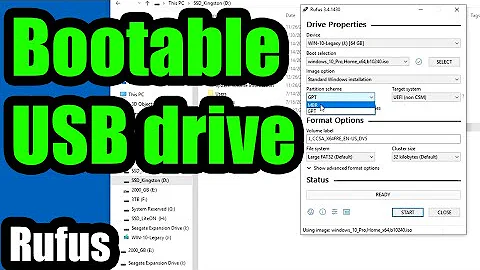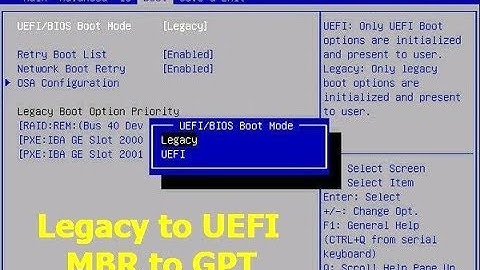Is there any way to boot Windows 7/8 using BIOS on GPT?
Solution 1
Well, things have changed since I first asked this question. For one, my PC is now UEFI based, so I don't have this problem anymore. Well, sort of. I had interest on pulling a similar setup on my laptop (GPT partitions, etc.) I finally managed to get a working Tianocore UEFI DUET setup, and it was about as painfully simple as it gets!
This assumes you want all shiny, new setups. If you want to actually convert your old setup, good luck. Actually, good luck either way, as this is a spotty operation in any situation.
A word of warning: If you're a fan of quick boot times, you may want to rethink this decision. Not that UEFI DUET is slow, but it adds another stage to your boot process, so if your BIOS/POST isn't fast, you may not like this.
Without further ado:
You'll want a Linux setup. I used Fedora 16 off of a USB stick (with UNetBootin) and I'd highly recommend that because it practically works out of the box. You need a USB drive anyway, so don't plan on continuing without one.
Grab some UEFI DUET builds. Without question, the best place to get this is here. The actual build tarballs are under the master branch of the first repository, here. Give it the old
tar -xf.Setup your partitions. You should reserve 200 MB somewhere on the disk (very much preferably the beginning, and first partition.) You can format it with FAT32, but we're reformatting it later. Just make sure it shows up as a partition. You should use GPT here.
Now install any additional software you may need. On the Fedora Live distribution, I found I needed
yum install gdisk. I think that was it.Now go into the extracted builds directory.
chmod +x ./duet-installand./duet-install -64 -F -m /dev/sda1(where/dev/sda1is your desired EFI system partition.)Cross your fingers and reboot. With any luck, you'll see the TianoCore logo in just a few moments. If so, you are probably good! You'll need to setup your OS installation files on a USB drive - Tianocore does not support CD-ROM/DVD-ROM drives out of the box (and I don't know of any drivers for it.)
You may also desire some UEFI shell binaries to play with. I found some here. Didn't test with Tianocore yet, though.
Anyway, thanks for everyone who tried to help.
Solution 2
I managed to boot Windows 8.1 on a GPT disk under a BIOS setup WITHOUT a second MBR disk.
The story was: My laptop was under a BIOS + GPT setup, with only Arch Linux installed. Recently I need to accomplish some tasks in Windows (which virtual machines cannot) so I am struggling to install Windows under my existing BIOS + GPT setup. According to Milind's answer, I managed to install Windows boot files (Boot, bootmgr, etc) to a (small) MBR USB drive. And each time I power on my laptop with that USB drive plugged in, I can boot into Windows 8.1, after which the drive can be plugged out safely.
The drawback is obvious: I need to carry a USB drive with me to boot Windows. So I was always trying to get rid of it.
After trying with different methods, I finally found the memdisk module of syslinux project worked.
- You need to give up Windows boot manager.
- You do not have to install syslinux. Only the memdisk module (a 26 kB file) is needed.
- You can use many bootloaders to load this module, in my case, my favourite bootloader GRUB (version 2).
Here is the outline of how-to:
- Partition your GPT disk to meet GRUB's needs, that is to say, a small partition to embed core.img. Detailed link
- Install GRUB to that small partition.
- Install Windows with
imagex.And use.bootsectandbcdbootto install Windows boot files into a small MBR USB disk. Useddordd_rescueto clone your small USB disk into a disk image. (Your USB disk has finished its job.) The image may be too big for memdisk to load, you can mount it and shrink the filesystem / partition in it.- According to my test, you do not need a physical MBR disk to install Windows boot files into. You can create a vhd file and treat it as a physical disk.
After installing Windows boot files into the vhd, you can convert it to raw (dd style) disk image using tools provided by VirtualBox or QEUM.When created withtype=fixed, the vhd file is just a normal raw disk image (dd-style) with 512 Bytes footer. The footer will be recognized as "unpartitioned space" and will be ignored, so atype=fixedvhd file can be directly fed to MEMDISK without converting and thus boot the Windows. - Configure GRUB to use memdisk to load this disk image.
- Windows will boot.
A detailed how-to can be found in my reboot.pro reply to Milind's thread.
Solution 3
If you even have a small spare drive, you can boot Windows(either 32 or 64 bit) from GPT on BIOS. A floppy will do.
Boot into the Windows install/repair disc.
Create the system drive on the small disk/floppy, and use bcdboot to put your boot files on the the newly created drive on the small disk. Add a bootsector with bootsect. Change the {bootmgr} device to boot. Boot from small disk.
Steps are detailed here.
Solution 4
Big thanks to wzyboy.
I faced with this problem when tried to install Windows 2012 to Dell PowerEdge 2950 with 6Tb RAID. It hasn't UEFI.
I carried out some experiments. First I created 32Mb virtual HDD, as wzyboy said, and simply copied all stuff from Microsoft reserved partition. Windows was started normally. But with this solution, Hyper-V service unable to start.
As memdisk wiki says, it automatically decide by image size, what of kind media it have to emulate. So, I created virtual 720K floppy in WMware environment, and copied bootmgr, BCD and bootstat.dat in it(just in case, deleted memtest submenu from BCD store). Floppy size I choozed as small as possible, so it may be bigger or even smaller, I don't tried.
Now it boots from GPT drive and Hyper-V works good.
P.S. may be third party software helps. Does anybody used anything like this? https://www.terabyteunlimited.com/bootit-bare-metal.htm
Solution 5
The article A BIOS to UEFI Transformation describes in detail how to use TainoCore UEFI DUET.
I understand that you have had problems using TainoCore, but perhaps this article will work for you.
The article does say :
Some computers don't work with UEFI DUET. Most importantly, it's really only useful on 64-bit x86-64 computers, especially in binary form. In fact, it doesn't start up properly even on some x86-64 computers. In tests on five x86-64 systems, I managed to get one or both versions working on just three computers—a pretty dismal success rate, really. It may just be coincidence, but the two computers that worked best for me used Intel CPUs, whereas the two that worked worst and the one that worked with version 2.1 but not version 2.3 all had AMD CPUs.
This seems to imply that one should try several versions of UEFI DUET before giving up.
It would help to know the model of your computer.
Related videos on Youtube
John Chadwick
Hello! I'm a programmer. I primarily run Linux, and I usually code in C, C++, Python or Javascript.
Updated on September 18, 2022Comments
-
John Chadwick almost 2 years
I'd like to know if there's a method to get Windows 7 or Windows 8 Developer Preview to install to a GPT disk on my traditional IBM PC BIOS setup. Windows 7, of course, rejects my GPT partition, because I don't have UEFI. Well, Debian and Grub 2 seem to work fine... So I want to know if there's a way to force Windows to work as well.
I'd seriously prefer avoiding hybrid MBR/GPT, because it's quite fragile and feels hackish, but it does work. I would assume the main blocker is that Microsoft is simply not adding support in their BIOS bootloader for GPT, which is understandable, I suppose. Is there any recourse?
The way I see it, there are a few potential solutions:
- Having an alternate bootloader for the Windows kernel. NOT a chainloader. As far as I know, none exist. That's a shame.
- Storing as little as possible on an alternate MBR-based disk. Not liking this idea, but it's doable. I'm not sure I'd call this a solution to the problem as much as a workaround.
- Emulating EFI enough to get the EFI bootloader to work... I remember hearing a bit about a UEFI-on-BIOS emulator, but I can't find anything about it now. I assume this is doable, but there's probably not much demand for it yet, and it's probably no fun at all to setup. GRUB 2 seems to be able to boot a hackintosh with necessary EFI emulation, but I guess there's no interest/UEFI 2 is harder to approach (and I would assume other EFI emulators used for hackintosh are on the same boat.)
- Coreboot with TainoCore. Coreboot does not work on my motherboard (as far as I know,) and I'm quite sure the last effort to do this during GSoC was a failure. I'd absolutely love this solution, if it did work, though.
Am I missing anything?
-
 Admin over 12 yearsNot quite. I know it can run on hybrid MBR/GPT and I'm not afraid to use it. More, I'm dissatisfied with that solution and want to know if there is another, better way. I'm still working on this issue, though, and I might find my own solution.
Admin over 12 yearsNot quite. I know it can run on hybrid MBR/GPT and I'm not afraid to use it. More, I'm dissatisfied with that solution and want to know if there is another, better way. I'm still working on this issue, though, and I might find my own solution. -
 Admin over 10 yearsI'm pretty sure That question is a duplicate of this one, given the 2 year disparity. Besides that, there is really no answer to the question there, or at least not a direct one, whereas this question has a direct answer.
Admin over 10 yearsI'm pretty sure That question is a duplicate of this one, given the 2 year disparity. Besides that, there is really no answer to the question there, or at least not a direct one, whereas this question has a direct answer. -
 Admin over 10 yearsDid you check my answer? It's new, and no one else has done it this way. Would like some testing on it. Guaranteed non hacky.
Admin over 10 yearsDid you check my answer? It's new, and no one else has done it this way. Would like some testing on it. Guaranteed non hacky. -
 Admin over 10 yearsIt really won't work on a laptop, though. But again, I find it awfully strange to flag this question as a duplicate after it was sufficiently answered nearly 2 years before that question was even asked. I do not find running a UEFI implementation to be hackish; just outlandish, but it has the advantage of not requiring additional disk drives.
Admin over 10 yearsIt really won't work on a laptop, though. But again, I find it awfully strange to flag this question as a duplicate after it was sufficiently answered nearly 2 years before that question was even asked. I do not find running a UEFI implementation to be hackish; just outlandish, but it has the advantage of not requiring additional disk drives. -
 Admin over 10 yearsThere is a single disk implementation in the works, will update when it's tested... Also, it's a hack in the sense that you're lying to windows about the system : in hybrid MBR, lying about the partition type, in DUET, lying about the firmware.
Admin over 10 yearsThere is a single disk implementation in the works, will update when it's tested... Also, it's a hack in the sense that you're lying to windows about the system : in hybrid MBR, lying about the partition type, in DUET, lying about the firmware. -
 Admin over 10 yearsAlso, I did not get a notification, please mention @MilindR so that it notifies...
Admin over 10 yearsAlso, I did not get a notification, please mention @MilindR so that it notifies... -
 Admin over 10 yearsgot the duplicate situation fixed :)
Admin over 10 yearsgot the duplicate situation fixed :)
-
John Chadwick over 12 yearsSince I last updated this question, I actually did get UEFI DUET to successfully boot on my computer. Sadly, the lack of a DVD-ROM driver killed me, as I didn't have any USB drives to store Windows on. After my primary harddrive randomly failed, I decided to give it a rest and use BIOS partitioning on a spare. However, this article is definitely helpful, and I'm still interested in getting this to work on my own. I'll try to remember to pick up a flash drive some time soon.
-
Zhuoyun Wei about 10 yearsTried that and it worked. Now I have a working Windows 8.1 on a GPT disk under a BIOS setup. All I have to do is to insert my USB flash drive to boot it. After booting process the USB drive can be removed. Just like the old times, I mean MS-DOS floppy...
-
Milind R about 10 yearsLol. I'm working on a solution that doesn't require another disk. Can you tell me how slow/fast it is?
-
Zhuoyun Wei about 10 yearsI think putting bootmgr on another disk does not make booting Windows longer, at least I does not feel it.
-
Zhuoyun Wei about 10 yearsOHHHH YES. Apologies for being too excited. I spent a whole afternoon and finally managed to boot Windows 8.1 on a GPT disk under a BIOS setupt WITHOUT a second (small) MBR disk - by using syslinux memdisk module which is capable of loading harddisk image.
-
Milind R about 10 years@wzyboy hey that's great. Please do report how you achieved it at the reboot.pro thread.
-
Zhuoyun Wei about 10 yearsHere is my post: reboot.pro/topic/…
-
 Nikolai Vakulenko about 10 yearsLately, after I spent many hours on image tricks, I found RAID-controller Perc5-i capable to slice array smaller then physical hard drive capacity. So, on professional hardware GPT booting isn't issue.
Nikolai Vakulenko about 10 yearsLately, after I spent many hours on image tricks, I found RAID-controller Perc5-i capable to slice array smaller then physical hard drive capacity. So, on professional hardware GPT booting isn't issue. -
Mihai Bişog almost 10 years@wzboy I'm using Arch linux and I managed to get after the point of installing windows (with wimlib-imagex). Now I'm not sure how to continue. Would you be able to elaborate on how to create the vhd file from within a linux distribution?
-
Zhuoyun Wei almost 10 years@MihaiBişog You need a Windows PE to create that vhd. There many ways to boot into Windows PE. GRUB and syslinux can boot into iso files, for example.
-
Powerman almost 10 yearsIsn't this will break windows updates? I mean, if Microsoft will release update which should modify these boot/bootmgr files which you put into virtual disk image - they won't be updated and you even never notice this. Also I suppose this may break some windows repair operations. Is there are any other downsides?
-
Milind R almost 10 yearsIn fact, BCD/Bootmgr will never be found by Windows, since it resides inside a floppy/disk image. So no question of auto-updating it. Auto-repair will not work. Anything related to microsoft tools related to your bootup will likely not work.
-
Zhuoyun Wei almost 10 yearsYes, anything related to bootmgr will not work, since they are "gone" after helping your Windows to boot. In fact, when you run "bcdedit" in cmd.exe it will tell you that it cannot find boot files. :-)
-
 Mokubai over 8 yearsI know that it has been some time since you posted this but is there any chance you could post the steps here for future users? Did you ever find a way to do this without an extra disk?
Mokubai over 8 yearsI know that it has been some time since you posted this but is there any chance you could post the steps here for future users? Did you ever find a way to do this without an extra disk? -
Milind R over 8 yearsCheck wzyboy's answer.
-
 Moab almost 8 yearsThis works with Windows installations?
Moab almost 8 yearsThis works with Windows installations? -
John Chadwick almost 8 yearsI was using it successfully with Windows 8 back in 2012. I don't need it anymore because everything made in the past few years uses UEFI, because Windows 8+ requires hardware manufacturers to support it. It probably would still work today, but I don't know if I would recommend it.
-
mixel over 7 yearsIn my case I needed to replace
harddiskwithrawinlinux16 /boot/syslinux/memdisk harddiskgrub config line. -
kirbyfan64sos about 7 yearsThe UEFI DUET link should now be here, but it is no longer maintained; the site says to use Clover EFI instead.
-
 phuclv almost 6 years@JohnChadwick you can use Clover and install it to HDD so that you don't need a separate boot drive anymore
phuclv almost 6 years@JohnChadwick you can use Clover and install it to HDD so that you don't need a separate boot drive anymore -
 phuclv almost 6 yearsBIOS doesn't know anything about the drive, whether GPT or MBR, or even BSD label or APM... It just loads the first sector (i.e. MBR) and run it. At that point the job of the BIOS can be considered "finished". If your drive doesn't boot, it just means that there's no valid boot sector on the drive
phuclv almost 6 yearsBIOS doesn't know anything about the drive, whether GPT or MBR, or even BSD label or APM... It just loads the first sector (i.e. MBR) and run it. At that point the job of the BIOS can be considered "finished". If your drive doesn't boot, it just means that there's no valid boot sector on the drive -
 phuclv almost 6 yearsand you can install Clover to HDD to remove the need of a separate drive
phuclv almost 6 yearsand you can install Clover to HDD to remove the need of a separate drive -
 harrymc almost 6 years@phuclv: Did you notice that the comment by John Chadwick is from 2011 and that he has given his own answer to this post?
harrymc almost 6 years@phuclv: Did you notice that the comment by John Chadwick is from 2011 and that he has given his own answer to this post? -
 phuclv almost 6 years@harrymc of course I know. That info is for future readers
phuclv almost 6 years@harrymc of course I know. That info is for future readers




